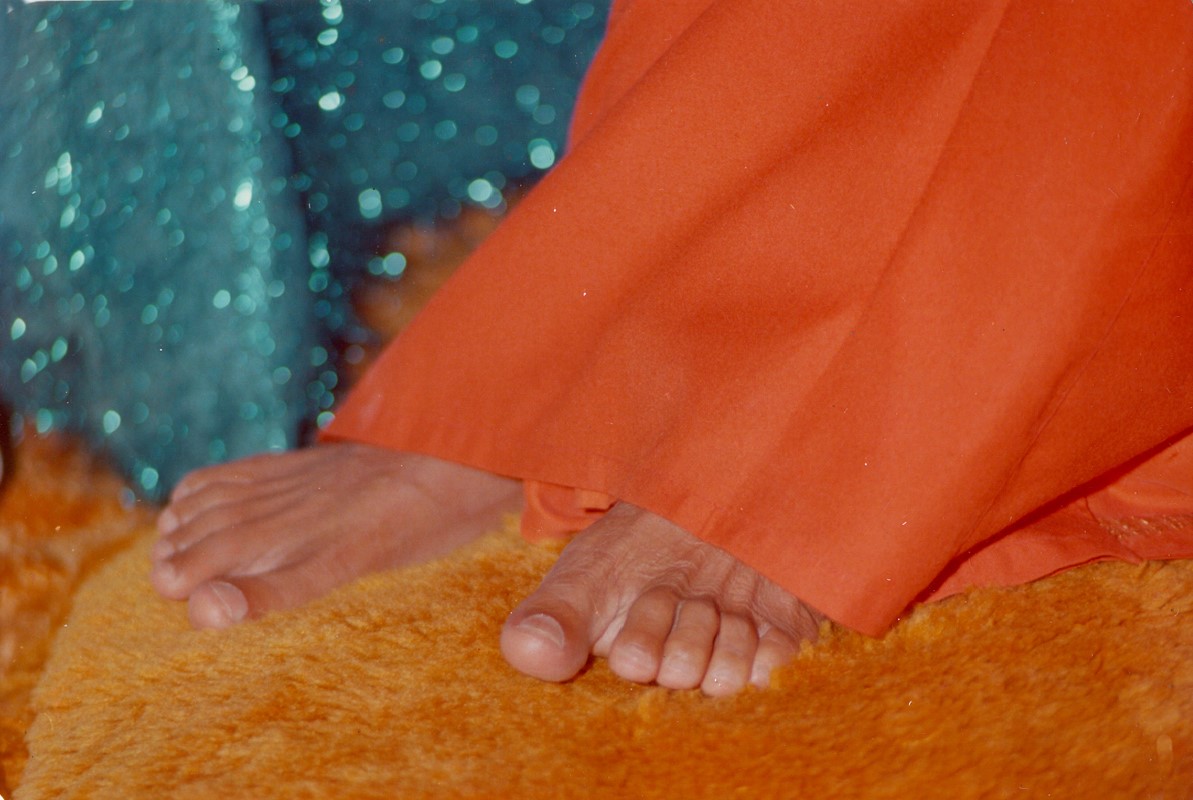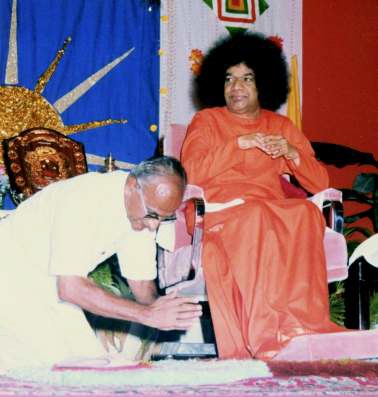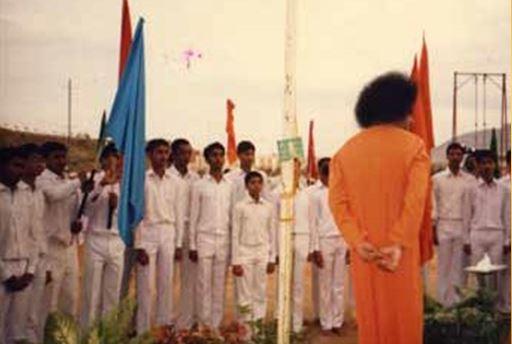My Sai Story- Prof. PC Sood
My Sai story began not as a devotee, nor as a seeker or even as an observer, but as an outsider. I first came to Parthi in early 1996 at the ripe old age as a casual visitor to meet a relative. I had no inkling whatsoever how the divine play was going to be enacted thereafter. My situation, thus, was in sharp contrast to that of a proverbially pampered tender-hearted pliable young Sai student. However, as we came to realize in due course, the loving care showered on this ‘non-entity’ by Swami was in no way less intense or less fulfilling than that He bestowed on His students. We learnt that Swami’s freely flowing Love is not bound by limitations of space, time or specific recipient. Every action and every interaction of His carries along with it pointers and guidelines for making one’s life more meaningful and more satisfying at the personal, societal and professional level equally. I invite every alumnus and every reader of this newsletter to share our joy and bliss through this brief narrative of a few illustrative experiences from our life in Sai land for over almost a quarter-century now.
Sai welcomes

During one of our early years in Parthi, the week-long birthday celebrations of Swami were in progress. In the morning preceding the convocation, Swami was distributing sarees to faculties’ wives sitting in the area around the arch in Sai Kulwant Hall. During this process, He held out a saree towards my wife sitting with the group. As she moved to get up, a Mahila devotee overseeing security, unaware of our position, made her sit down, and Swami handed over the saree to another lady. A few moments later, Swami made the same gesture again, however, the same scene was played out. During our lunch, my wife, with tears in her eyes, described to me what happened. The same day during evening Darshan, Swami came to me and asked, “Did your wife get a saree this morning?” “No Swami” was my reply. Hearing it, Swami signalled to his attendant who rushed to the interview room and returned with a saree. Handing over the same to me, Swami proclaimed, “Give it to your wife – from Me.” You can well imagine how blessed and thrilled we were by this loving act of Sai, which, incidentally, also conveyed to all concerned that we, the newcomers, belonged to the Sai fold henceforth. This incident also teaches us an important life lesson. When faced with a potentially painful situation, do not react rashly. A careful, calm handling thereof can yield cherished result even in such a case.
One-on-one with Sai
One of the most eagerly sought boons by any visitor to Parthi is a call for an interview by Swami. Within the confines of that small (hardly 10’×10’) room, one gets to see certain traits of Swami rarely noticed in public. In the interview room, Swami acts as a perfect host. For example, He Himself opens the door to welcome you in gracefully leading you to a comfortable seat. He switches on the fan, etc. Most significantly, during person-to-person interaction He makes you feel as if nothing else exists for Him at that moment, even when thousands of devotees are seeking His attention just outside the door. Herein lies an important lesson in behavioural science. If you can make the person in front of you feel that you are 100% with him, the job at hand is already more than half accomplished. Several other facets of Sai – as the Antaryami, Guru and Guide – sensitive to your inner feeling and responsive to your outside needs were revealed to us in the one-to-one interaction with Him as illustrated in the following paragraphs.

In our first interview, seven devotees (four men and three women including my wife and myself) were called in. After preliminaries, Swami created a gold pendant with Lord Rama’s imprint and passed it around starting with the ladies side. It happened that Rama was my wife’s Ishta Devatha (favourite deity) at home. When the pendant came into her hand, she prayed inwardly, “Swami, please do not tempt me. I do not want any jewellery from you. Please help me overcome my shortcomings (vikars)”. The merciful Antaryami Lord heard her unspoken plea. After the round was completed, Swami gifted the pendant to another lady – a teacher from the Anantapur campus. Over the next decade, He did not gift her any jewellery. In 2005, however, during our re-enacted wedding ceremony, as a part of Bhimaratha Shanthi Mahotsav, He gave her Mangal Sutra, diamond earrings and everything else as part of Kanyadan. On various occasions, He gifted her even more cherished items, such as a talismanic Shiva Lingam (which I have described later) and His robe on three different occasions. Surprise of surprises – He also fulfilled one of her long-held wishes. She used to repeatedly sing the song “Mera haath pakad lo”. Thus, while coming out after another interview, He directed my wife and me to stand on either side of Him, while He firmly held our hands. He called the official photographer to take our picture in that pose. Ever since this photo has adorned our living room wall. It reassures us at every moment of His continuing grace on our family. Truly, only divinity can be so sensitive to such sensitivities of mere mortals as and when considered fit.
During the very first interview Swami created a three-diamond ring for me which, of course, fitted perfectly on my finger. I was told that the three diamonds were to continually remind me of the 3Ps:
P1 stands for Purity. Before undertaking any project, carefully and critically examine if it is worth doing.
P2 stands for Patience. Having decided on the project, do not just jump in. Take time to draw up a workable plan.
P3 stands for Perseverance. After starting on the project, do not give up in haste, even when hurdles come your way. Fight till the end. Keep at it till success is achieved.
Since then, I have passed on this mantra to a number of my students. If practised diligently, it assures success in any venture.
Work is worship
In academic circles, I have been often called a “Living Miracle of Sai” who personifies one aspect of Sai dictum ‘Work is Worship’. Even after almost a quarter-century in Sai land, I hesitate to term myself a devotee as understood traditionally. I do not routinely practice any puja path, no meditation sessions, no study circle deliberations, and so on. To understand this dilemma, let us look back to the beginning of my third innings.
The following mini-interview took place during evening Darshan in Sai Kulwant Hall on 2nd November 1998 (as recorded on page 37 of Sai students’ publication Heart to Heart, Part II – 1998-2002)
Swami: (To a visiting professor) What are you going to do after retirement?
Professor: Swami, I want to serve you.
Swami: I don’t want any service. Do work at our institute. Which subject?
Professor: Swami, Physics.
This is how my assignment to work in SSSIHL was formally and openly confirmed by the Founder Chancellor of the Institute.
Earlier, on meeting the Head of the Department of Physics, I was handed a PhD thesis with the remarks, “Sir, this teacher of ours has just been awarded PhD in Nuclear Physics, but he has no published research to date. Can you please help?” I came to realize much later that it was just a part of the divine play. An irresistible ‘bait’ had been thrown by the Talent Hunter to bring in the marked ‘hunted’. Needless to say that I was properly ‘hooked’. I took up the challenge. Over the next 13 years, this teacher co-authored with me 35 research publications. During the past 22 years (1997-2019), a total of 93 research papers have been co-authored by me with nine different teachers of all three campuses and scores of PG students (projects) with SSSIHL affiliation.
This statistics could well be from any good academic/research institute. What makes this work worthy of being termed as worship can be understood by looking at my background and at the working environment available locally. My early life in Punjab was shaped by two contrasting influences. On the positive side, I count my education in DAV institutions and my social environment including the Vedic Renaissance movement (Arya Samaj) and the practices and teachings in Sikh Gurudwaras. Thus our functional religion included minimal ritualistic pooja practices (in comparison to South India). In this cultural upbringing we were led to believe that there is only one (formless) God who is eternally present in all beings and who can be realized in any form by a true seeker. On the negative side was the Partition of 1947 wherein all basic human values, even human lives, were brutally put to rest in the name of religion. The next 40 years of my academic life had a one-point focus on Nuclear Research spread across a wide multinational canvas.
It was against this background that our Antaryami Swami assigned me the designated task. It may surprise those not in the know that most of my research as a Theoretical Physicist was actually carried in Mandir. My collaborators and students too were encouraged to meet me around Darshan time in Sai Kulwant Hall for scientific discussions. Swami also used to personally monitor and support our research efforts on a regular basis. Almost each one of our finished manuscripts for journal publication was physically scanned and blessed by Swami.

What other proof one needs for the assertion that our Swami regarded my work as my pooja (worship) in the format I was equipped to perform.
Vaidyaraj Swami
Time and again Swami reminds us that, when you sincerely take up an assigned task in the Sai mission, Swami takes over responsibility for all your personal obligations, including well being of all your family members. We have been personally blessed with such Sai care on various occasions. Two such instances are sketched out below.
Before we arrived in Parthi, my wife had been under regular medication related to a variety of health concerns, such as hypertension, angina, high BP, anxiety, etc., for over a decade. We had made no mention of this fact to Swami in any of our earlier interviews. Next time we were called in, Sarvantaryaami Swami created a Shiva Lingam and gave the same to my wife. He instructed, “Do Abhishekam of this Lingam every day and both of you drink the Theertham. Stop all medicines! This is Sanjeevani. Further, whosoever comes to you in faith, give it to them also. This is your Seva”. Our elder daughter and her husband are both doctors. When we conveyed these instructions to them the same evening, they were quite apprehensive since these long-in-use strong medicines have to be gradually withdrawn. However, with full faith in the divine prescription, we stopped all medicines from that very evening itself. Her health gradually improved with no withdrawal side effects or health problems troubling her from then.
We would like to add another instance of long-distance healing by Sai of a critical health concern of our family member. In mid-December, 2007, our elder daughter phoned us from Varanasi to inform us that our twelve-year-old granddaughter Nashi was critically ill. About a fortnight ago, the little girl had developed a high fever which would not subside even with any prescribed medicines. A week later, she developed symptoms of pneumonia, which again proved resistant to the best available medical care. The child had grown very weak and her parents (both doctors) were considering taking her to Delhi or Mumbai for effective medical care. Our daughter pleaded with us to pray to Swami for Nashi’s well being. We immediately wrote a letter to Swami describing the situation, adding that even in her infancy, Nashi could pick out her “Sai Baddah” (being too young then to pronounce properly) from a multitude of photographs. Further, not finding Nashi’s individual photo, we cut her profile picture from a group snap and pasted it on the letter.
During evening Darshan, Swami came up to me, took my letter and started reading it there and then. In the process, He softly caressed her photo and moved on. After Aarathi, we phoned Varanasi to inform them of this happening. Our son-in-law came on the phone and asked, “What time Swami touched Nashi’s photo?” “Around 5.30 pm.” was our reply. Excitedly he said, “Around 5.30 this evening, Nashi suddenly felt at ease. Presently, she is resting peacefully for the first time after two weeks of painful tossing and turning”. To cap it all, Nashi had a complete medical checkup later. The wonder of wonders – scans did not show even a single patch from pneumonia, which were very much in evidence a few days ago. The merciful Lord had indeed taken over responsibility for our family’s well being even from thousands of kilometres away.
Form to formless
One of the most persistent and perplexing questions faced by the Sai community, more so the alumni, during the past nine years is “How to understand and function in the post-physical Sai era?” Such confusion basically arises from our viewing all happenings in the space-time frame of reference (STFOR), while ignoring the fact that STFOR is not a divine prescription, it is merely a human artefact. In the following, I shall try to clarify the situation on four fronts.
Firstly, I quote the opening lines of a recent popular Bhajan.
“Kahe Bandhe Sai ko,
Janam Maran ke Bandhan Mein
Kya iss sathya ko bhool gaye?
Sai basey hain kan kan mein”
The basic truth, enunciated in the last line above, is proven both literally and scientifically. Each spec (kan) of matter is composed of five basic elements (Panch Tatwa) namely, BHoomi, AGni, Vayu, AAkash and Neer (water). The acronym reads ‘Bhagvaan’ verifying that Sai Bhagvaan is indeed the indestructible component of all existence. The formless exists in all forms. Next, we look at the nomenclature of the divine as Paramatma. Literally, and grammatically, we describe three stages of human evolution (as also of every happening) as Atma, Mahatma and Paramatma.

Thus, we acknowledge the eternal truth that Atma and Paramatma are basically one and the same timeless entity at different stages of evolution. The Hrudyanivasi Sai was, is, and will always be with us in whatever form we choose to perceive Him. In this context, it is relevant to point out that in Sai Kulwant Hall, Aarti is performed – not at the Samadhi wherein Swami’s mortal body rests, neither at the recently added moorti (statue) of Swami inside the Mandir, but only at the throne ‘occupied’ (even this day, as we all believe) by Him.
Finally, at the personal level, I wish to emphatically state that, at every moment in the post-April 2011 era, we have truly felt that Swami is with us, guiding us, supporting us even now as intensely as He did when He was physically with us.
An appeal
This appeal is particularly addressed to the alumni who left the portals of the Institute more than a decade ago and who aim to make “My life ↔ His message”. Let us face reality, as evident in SSSIHL and other Sai academic institutions. As years go by, we realize that students entering our institutions each year are farther and farther deficient in Sai Samskars, as was earlier prevalent in respective homes and surroundings. This fact leads to a deficiency in self-imposed discipline and dedication, which have been essential hallmarks of a Sai student. You, senior alumni, can play a positive role in overcoming this deficiency. Come, adopt and nurture such a new-comer at a person-to-person level wherever you happen to be. Joth se joth jaley and thus the chain shall spread. Let us join hands in this holy mission and we shall find Sai support in such a venture at each step. Let us all pray together to be deserving of divine grace in our every effort.
About Professor PC Sood
Subsequent to his 1988 retirement after an eventful 20 years in Benaras Hindu University holding multiple positions as Professor, Head of Department, Dean, and Director amongst others, he chose to pursue intensive research in Nuclear Structure Physics through active in-person international collaboration. For this, he divided his time between California (Livermore), Florida (FSU) Canada (McMaster) and India (BHU). Results from this effort over seven years were published in over 50 research publications in international journals of repute. This effort peaked in 1995 when six papers were published in quick succession in successive issues of The Physical Review co authored with scientists from seven different nations. Since 1996, Professor has been involved with Sri Sathya Institute of Higher Learning




